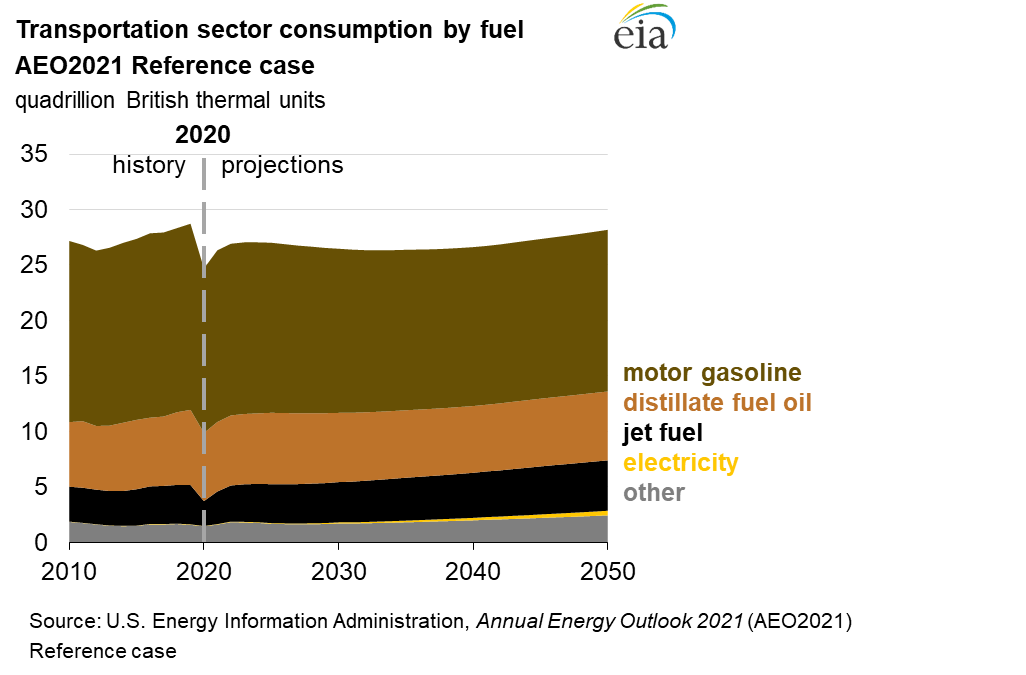
- Key takeaways from the Reference case and side cases
- The Annual Energy Outlook 2022 explores long-term energy trends in the United States
- What is the AEO2022 Reference case?
- What are the side cases?
- Motor gasoline remains the most prevalent transportation fuel despite electric vehicles gaining market share
- Energy-related carbon dioxide (CO2) emissions dip through 2035 before climbing later in the projection years
- Energy consumption increases through 2050 as population and economic growth outweighs efficiency gains
- Electricity continues to be the fastest-growing energy source in buildings, with renewables and natural gas providing most of the incremental electricity supply
- Electricity demand grows slowly across the projection period, which increases competition among fuels
- Renewable electricity generation increases more rapidly than overall electricity demand through 2050
- Battery storage complements growth in renewables generation and reduces natural gas-fired and oil-fired generation during peak hours
- As coal and nuclear generating capacity retire, new capacity additions come largely from wind and solar technologies
- U.S. production of natural gas and petroleum and other liquids rises amid growing demand for exports and industrial uses
- Driven by rising prices, U.S. crude oil production in the Reference case returns to pre-pandemic levels in 2023 and stabilizes over the long term
- Refinery closures lower domestic crude oil distillation operating capacity, but refinery utilization rates remain flat over the long term
- Consumption of renewable diesel increases as a share of the domestic fuel mix
The amount of crude oil processed at U.S. refineries decreased in 2020 because of lower demand for transportation fuels, but it returns to 2019 levels by 2025
Lower refinery throughput in 2020

As people stayed home and avoided nonessential travel during the pandemic, domestic (and global) demand for transportation fuels in 2020 decreased. Weekly U.S. consumption estimates for motor gasoline in particular recorded their lowest levels since January 1994. In response, U.S. refineries altered their operations to adjust to less end-use product demand, and total refinery throughput decreased in 2020.
Refineries can change their petroleum product output by changing how often and in what manner the downstream that processes the output from distillation units are run. Beginning in late March of 2020, because of responses aimed at slowing the spread of COVID-19, refinery yields for liquid fuels began to fall, as did refinery utilization. Crude oil throughput, or the amount of crude oil processed at refineries, decreased in 2020. In the Reference case, however, total refinery throughput returns to pre-COVID levels in about 2025, and utilization returns to pre-COVID levels sooner because of the permanent closures of some refining capacity.

Petroleum trade
In addition, refineries have lower capacity as a result of several closures and conversions of refineries in 2020. This factor puts further downward pressure on total crude processing, resulting in less petroleum product and more crude to be exported. The projected increase in domestic crude oil production, recovery in global liquid fuels demand, and increase in U.S. refinery inputs means the U.S. returns to net petroleum exporter status, on a volume basis, by 2024.

In the Reference case, the United States is both an importer and exporter of petroleum liquids, importing mostly heavy crude oil and exporting mostly petroleum products such as gasoline and diesel. Even though product exports in 2020 were lower than previous years, the AEO2021 Reference case projects relatively high levels of exports for petroleum and other liquids exports through 2050. These high export levels are primarily a result of less consumption of liquid fuels in the United States and, to a lesser extent, a result because of domestic production of crude oil that cannot be processed economically domestically and is more valuable when exported. Net exports of petroleum and other liquids hold steady in the Reference case and stay in a similar range for the rest of the projection period.
The side cases illustrate the variable nature of U.S. petroleum trade. In the High Oil and Gas Supply side case, more resources and more availability result in increased domestic production and net exports. The High Oil Price case shows similar results: high production levels and accompanying exports. Whether it be higher supply or higher price, the effect is the same—the United States remains a net exporter during the entire projection period for those two cases. The opposite occurs in the Low Oil and Gas Supply case and Low Oil Price case. Generally, as a result of many possible oil price paths, production and throughput remain significantly uncertain.
In AEO2021’s Reference Case, the United States remains a net exporter of petroleum and other liquids, but the balance of imports to exports is highly sensitive to supply, demand, and price factors.
-
Additional information:
-
- Monthly Energy Review
- Short term Energy Outlook
- Changing demand for petroleum products has led to operational changes at U.S. refineries
- Demand for jet fuel in the U.S. is recovering faster than in many other marketsU.S. petroleum refining capacity falls to its lowest level since May 2016
- Weekly Petroleum Status Report
- Refinery utilization and capacity data
-
Previous Editions of the AEO
-
Documentation and Assumptions